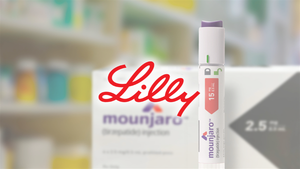
Life sciences tools company Agilent Technologies (NYSE: A) beat Wall Street’s revenue expectations in Q4 CY2024, with sales up 1.4% year on year to $1.68 billion. On the other hand, next quarter’s revenue guidance of $1.63 billion was less impressive, coming in 1.4% below analysts’ estimates. Its GAAP profit of $1.11 per share was in line with analysts’ consensus estimates.
Is now the time to buy Agilent? Find out by accessing our full research report, it’s free.
Agilent (A) Q4 CY2024 Highlights:
- Revenue: $1.68 billion vs analyst estimates of $1.67 billion (1.4% year-on-year growth, 0.6% beat)
- EPS (GAAP): $1.11 vs analyst estimates of $1.12 (in line)
- Adjusted EBITDA: $488 million vs analyst estimates of $466.8 million (29% margin, 4.5% beat)
- The company dropped its revenue guidance for the full year to $6.72 billion at the midpoint from $6.83 billion, a 1.6% decrease
- Operating Margin: 22.4%, in line with the same quarter last year
- Free Cash Flow Margin: 19.9%, down from 23.8% in the same quarter last year
- Organic Revenue rose 1.2% year on year (-6.3% in the same quarter last year)
- Market Capitalization: $38.28 billion
Company Overview
A 1999 spin-off of Hewlett-Packard, Agilent Technologies (NYSE: A) offers analytical instruments, software, and services for laboratories in healthcare, environmental sciences, and food safety.
Research Tools & Consumables
The life sciences subsector specializing in research tools and consumables enables scientific discoveries across academia, biotechnology, and pharmaceuticals. These firms supply a wide range of essential laboratory products, ensuring a recurring revenue stream through repeat purchases and replenishment. Their business models benefit from strong customer loyalty, a diversified product portfolio, and exposure to both the research and clinical markets. However, challenges include high R&D investment to maintain technological leadership, pricing pressures from budget-conscious institutions, and vulnerability to fluctuations in research funding cycles. Looking ahead, this subsector stands to benefit from tailwinds such as growing demand for tools supporting emerging fields like synthetic biology and personalized medicine. There is also a rise in automation and AI-driven solutions in laboratories that could create new opportunities to sell tools and consumables. Nevertheless, headwinds exist. These companies tend to be at the mercy of supply chain disruptions and sensitivity to macroeconomic conditions that impact funding for research initiatives.
Sales Growth
A company’s long-term sales performance can indicate its overall quality. Any business can put up a good quarter or two, but many enduring ones grow for years. Over the last five years, Agilent grew its sales at a mediocre 4.5% compounded annual growth rate. This fell short of our benchmark for the healthcare sector and is a rough starting point for our analysis.
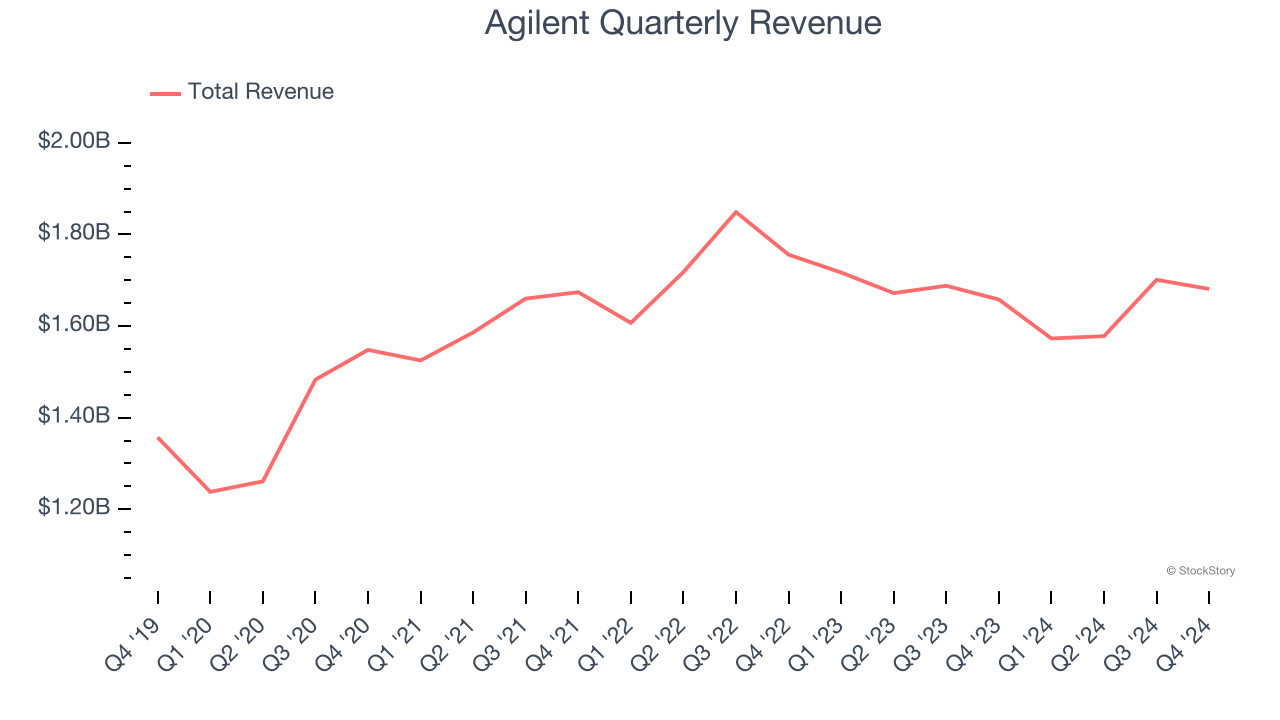
Long-term growth is the most important, but within healthcare, a half-decade historical view may miss new innovations or demand cycles. Agilent’s history shows it grew in the past but relinquished its gains over the last two years, as its revenue fell by 2.9% annually. 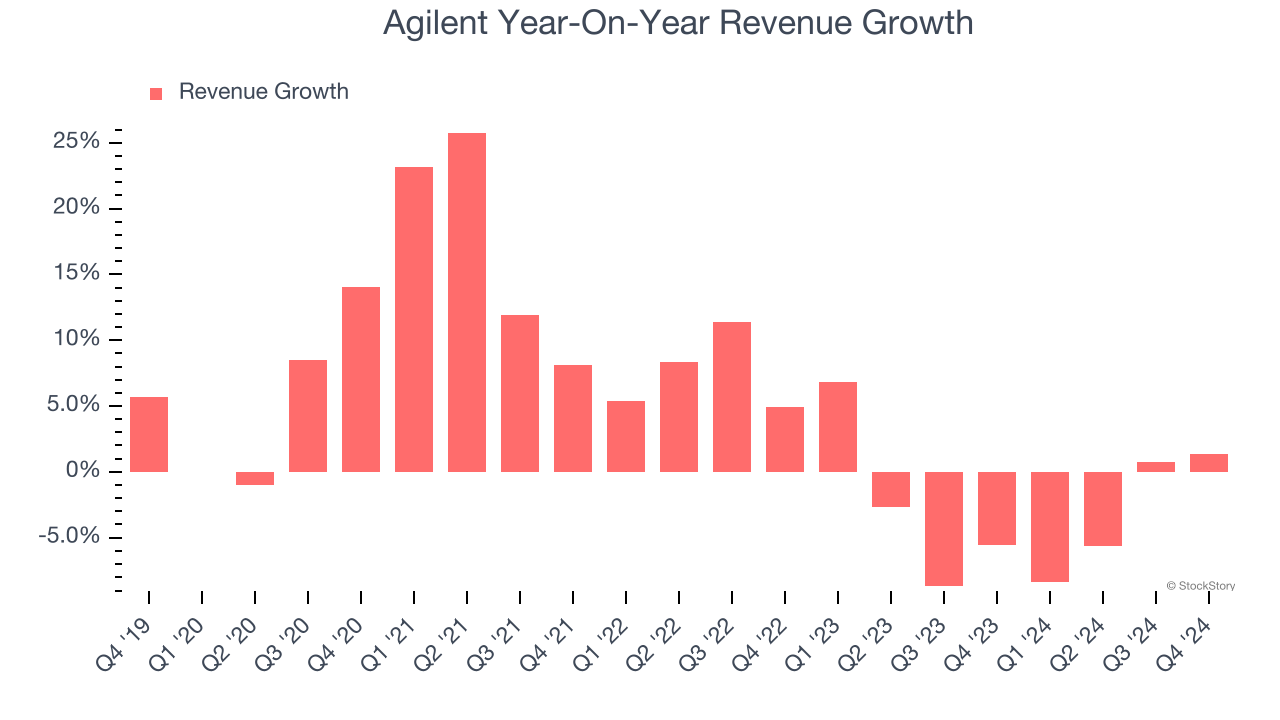
Agilent also reports organic revenue, which strips out one-time events like acquisitions and currency fluctuations that don’t accurately reflect its fundamentals. Over the last two years, Agilent’s organic revenue averaged 2.5% year-on-year declines. Because this number aligns with its normal revenue growth, we can see the company’s core operations (not acquisitions and divestitures) drove most of its results. 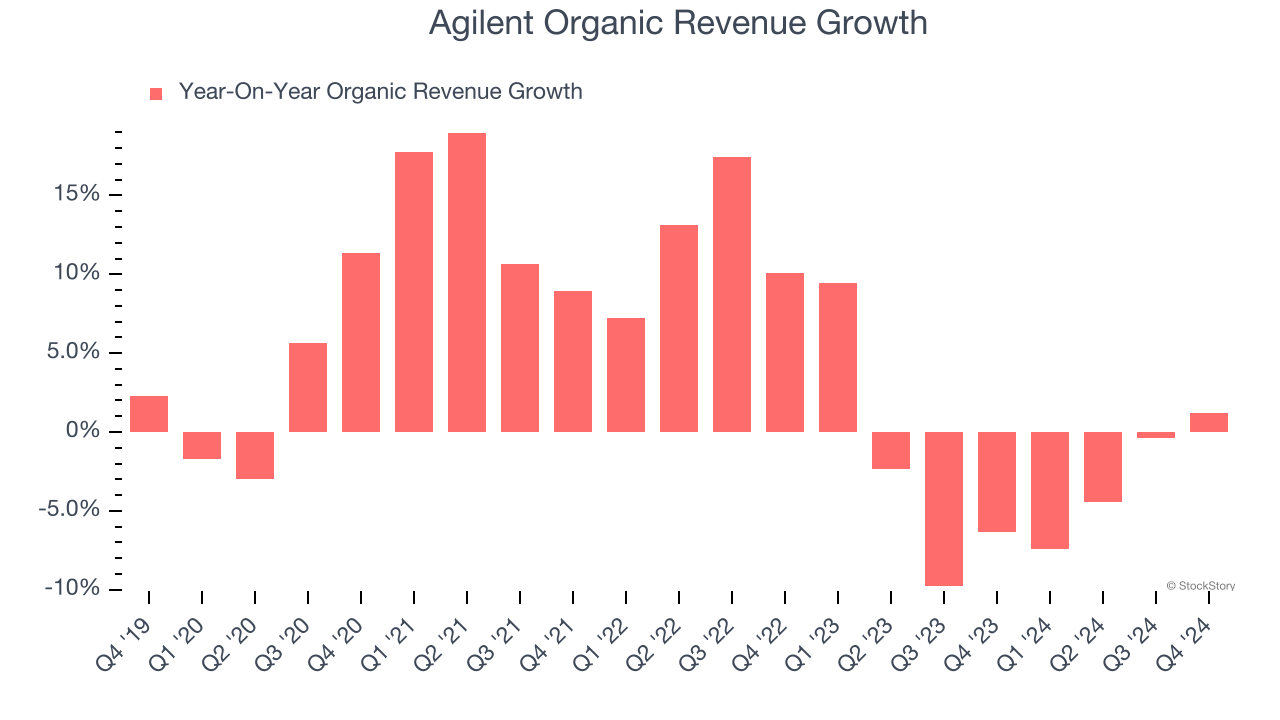
This quarter, Agilent reported modest year-on-year revenue growth of 1.4% but beat Wall Street’s estimates by 0.6%. Company management is currently guiding for a 3.6% year-on-year increase in sales next quarter.
Looking further ahead, sell-side analysts expect revenue to grow 6% over the next 12 months, an improvement versus the last two years. This projection is above average for the sector and suggests its newer products and services will fuel better top-line performance.
Today’s young investors won’t have read the timeless lessons in Gorilla Game: Picking Winners In High Technology because it was written more than 20 years ago when Microsoft and Apple were first establishing their supremacy. But if we apply the same principles, then enterprise software stocks leveraging their own generative AI capabilities may well be the Gorillas of the future. So, in that spirit, we are excited to present our Special Free Report on a profitable, fast-growing enterprise software stock that is already riding the automation wave and looking to catch the generative AI next.
Operating Margin
Agilent has been an efficient company over the last five years. It was one of the more profitable businesses in the healthcare sector, boasting an average operating margin of 21.2%.
Analyzing the trend in its profitability, Agilent’s operating margin rose by 5.3 percentage points over the last five years, as its sales growth gave it operating leverage. Zooming into its more recent performance, however, we can see the company’s margin has decreased by 1.4 percentage points on a two-year basis. If Agilent wants to pass our bar, it must prove it can expand its profitability consistently.
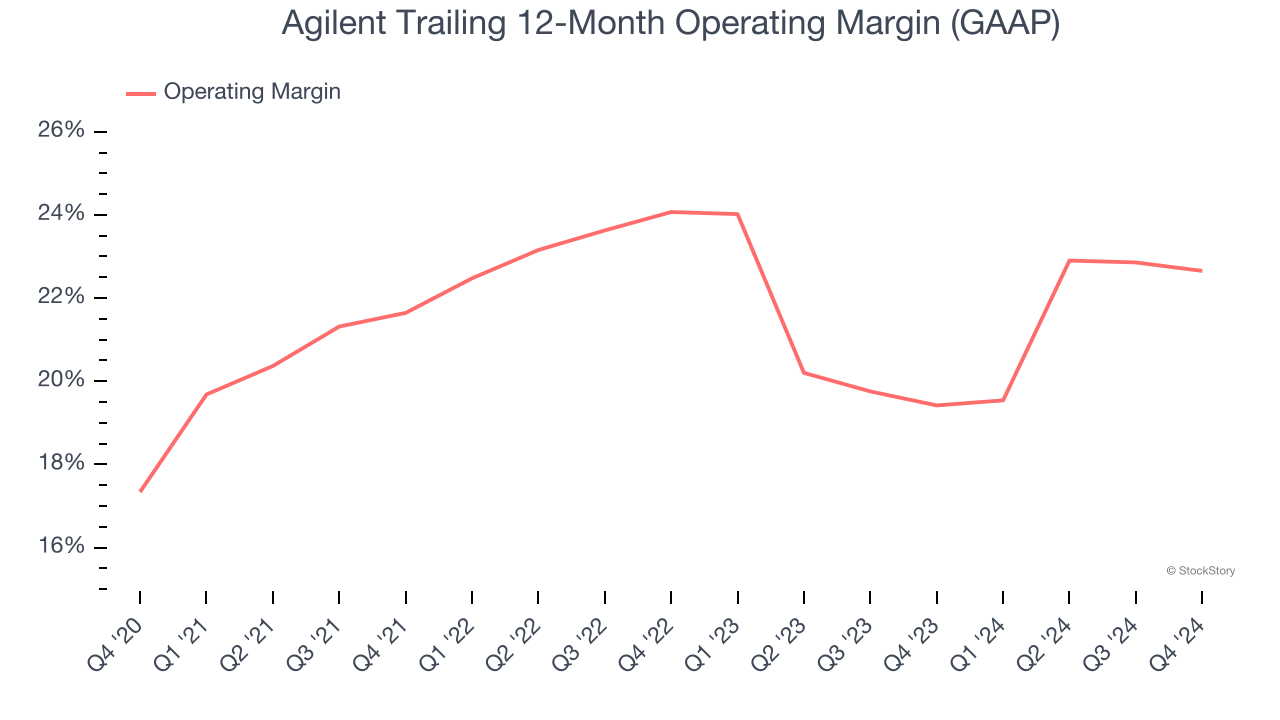
This quarter, Agilent generated an operating profit margin of 22.4%, in line with the same quarter last year. This indicates the company’s overall cost structure has been relatively stable.
Earnings Per Share
We track the long-term change in earnings per share (EPS) for the same reason as long-term revenue growth. Compared to revenue, however, EPS highlights whether a company’s growth is profitable.
Agilent’s EPS grew at a spectacular 12.4% compounded annual growth rate over the last five years, higher than its 4.5% annualized revenue growth. This tells us the company became more profitable on a per-share basis as it expanded.
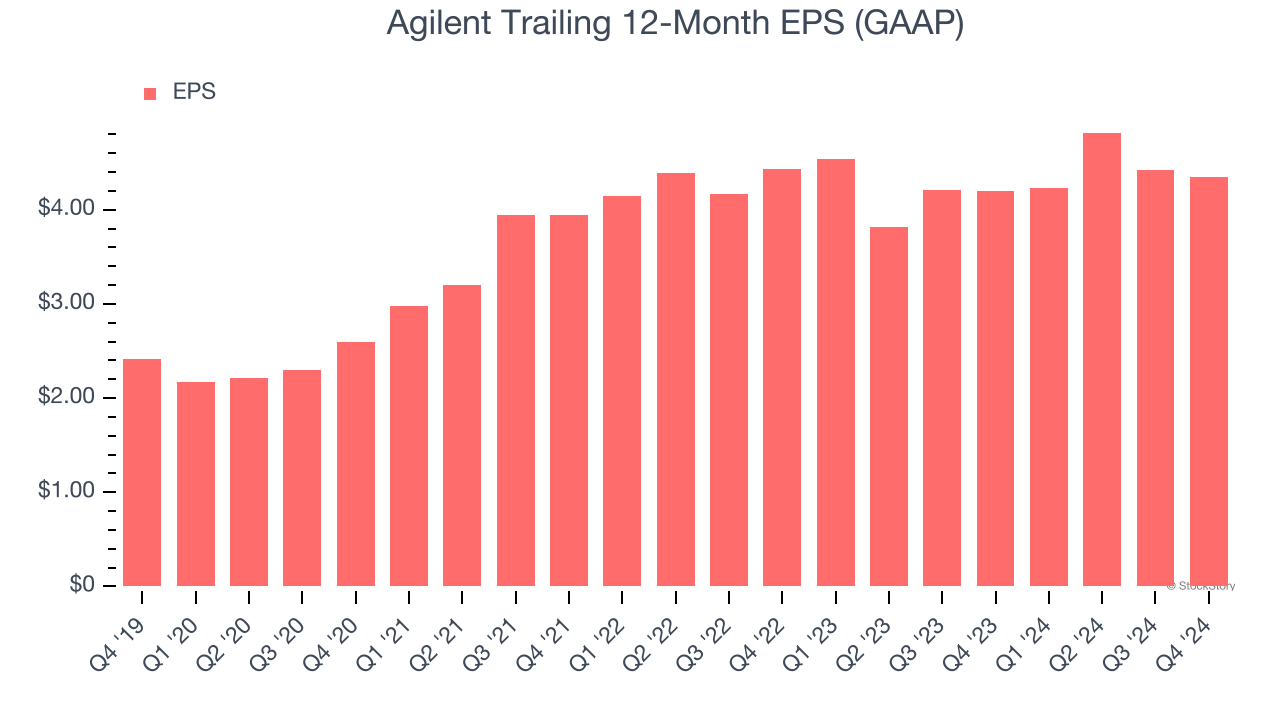
Diving into the nuances of Agilent’s earnings can give us a better understanding of its performance. As we mentioned earlier, Agilent’s operating margin was flat this quarter but expanded by 5.3 percentage points over the last five years. On top of that, its share count shrank by 8.3%. These are positive signs for shareholders because improving profitability and share buybacks turbocharge EPS growth relative to revenue growth. 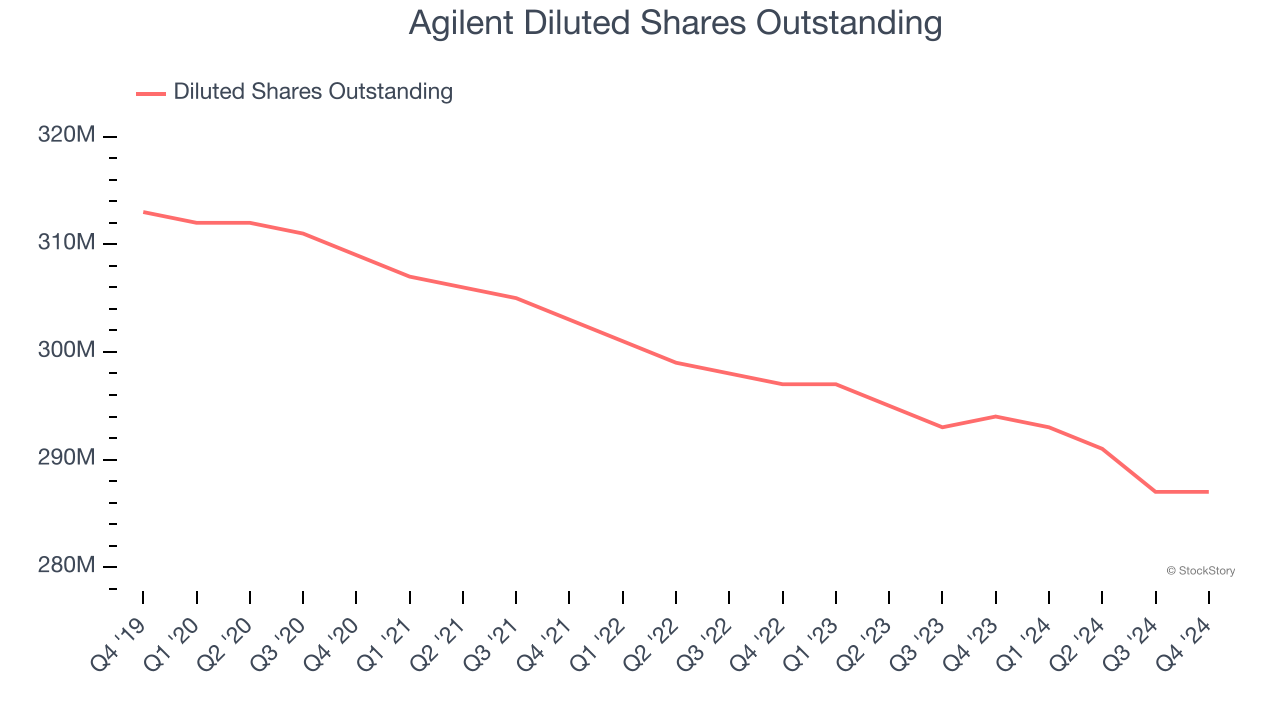
In Q4, Agilent reported EPS at $1.11, down from $1.18 in the same quarter last year. This print was close to analysts’ estimates. Over the next 12 months, Wall Street expects Agilent’s full-year EPS of $4.35 to grow 17.8%.
Key Takeaways from Agilent’s Q4 Results
We enjoyed seeing Agilent beat analysts’ organic revenue expectations this quarter. We were also happy its revenue narrowly outperformed Wall Street’s estimates. On the other hand, its revenue guidance for next quarter slightly missed and its full-year revenue guidance fell short of Wall Street’s estimates after being lowered. Lowered full-year revenue guidance is never a good sign, as it likely shows worsening demand trends. Overall, this quarter could have been better. The stock traded down 3.6% to $129.47 immediately after reporting.
So do we think Agilent is an attractive buy at the current price? What happened in the latest quarter matters, but not as much as longer-term business quality and valuation, when deciding whether to invest in this stock. We cover that in our actionable full research report which you can read here, it’s free.


